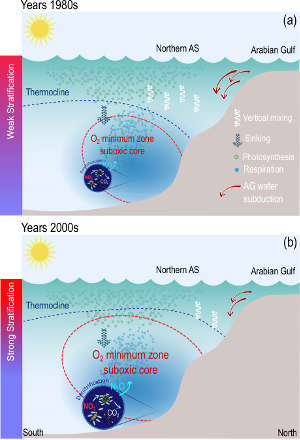Using AI to control energy for indoor agriculture
30 September 2024
Published online 12 November 2021
Warming waters have been driving Arabian Sea deoxygenation for decades.

Zouhair Lachkar (2021)
Enlarge image
The scientists, led by Zouhair Lachkar, used simulations of oxygen decline in the upper layers of the Arabian Sea between 1982 and 2010 to estimate and explore the factors controlling the expansion of the oxygen minimum zone (OMZ), known as the dead zone, where oxygen saturation is at its lowest.
They identified significant deoxygenation in the northern Arabian Sea in the 1980s and 90s, with oxygen levels falling more than 6% per decade. This corresponded to an expansion of the dead zone at a rate of 0.6% per decade. In addition, these changes were accompanied by an increase in denitrification by up to 40% over the study period.
The researchers suggest the expansion of the dead zone is largely attributable to a widespread warming of the sea surface, which causes a reduction in the ventilation of subsurface layers. They also found that more intense summer monsoons contribute to lower oxygen levels in the upper ocean.
“Our simulations suggest that the fast warming of the sea surface over the last few decades has had two consequences: a significant reduction in vertical mixing, especially in winter, and an increase in the Gulf water buoyancy that limited its subduction in the northern Arabian Sea,” says Lachkar. “Combined, these two mechanisms have contributed to inhibiting the ventilation of the Arabian Sea oxygen minimum zone core located in the intermediate layers of the northern Arabian Sea.”
The scale of oxygen depletion is thought to have led to a dramatic shift in the regional dominance of diatoms to large dinoflagellates. This has severely disrupted the ecological balance, as diatoms are the primary energy source for fish. The Gulf warming has also been linked to major biogeochemical changes, such as recent mass coral bleaching events2 .
The study revealed a weaker rate of deoxygenation in the 2000s. However, Lachkar points out: “In a more recent simulation that we are currently analysing and that extends to 2018, we find a significant deoxygenation rate again in the 2010s.”
Bastien Queste, an oceanographer at the University of Gothenburg, Sweden, who was not involved in the study, says the findings are “critical for understanding how the region may be affected in the future, especially as it remains one of the less observed regions in the world despite its importance.”
doi:10.1038/nmiddleeast.2021.92
Stay connected: